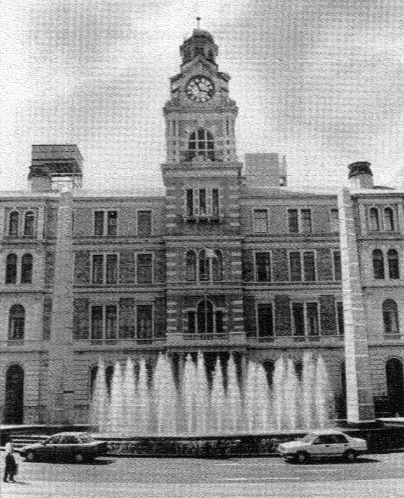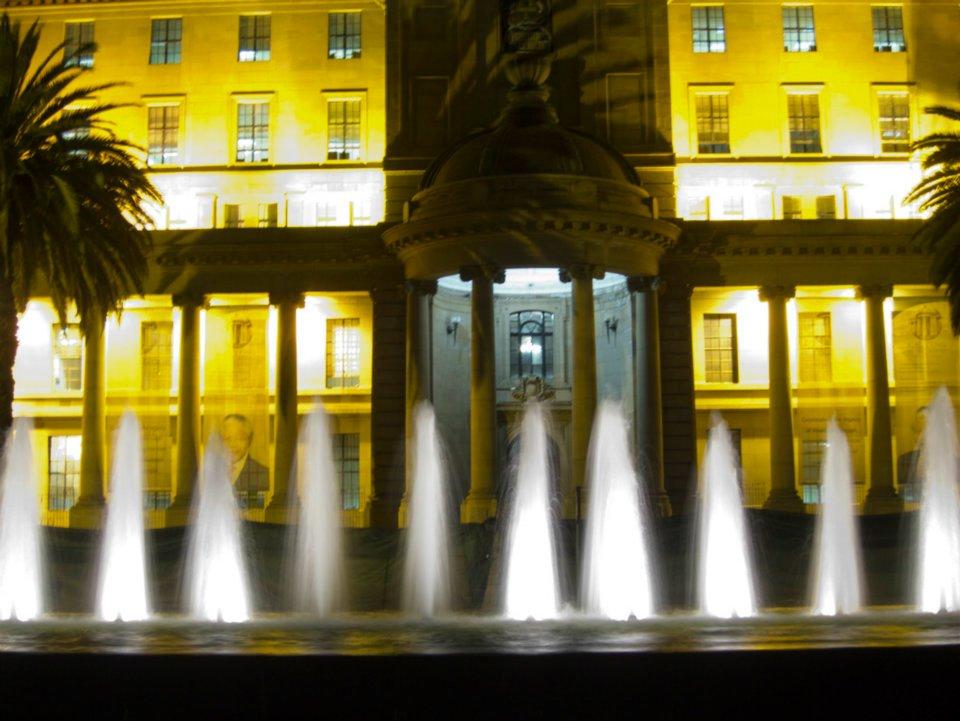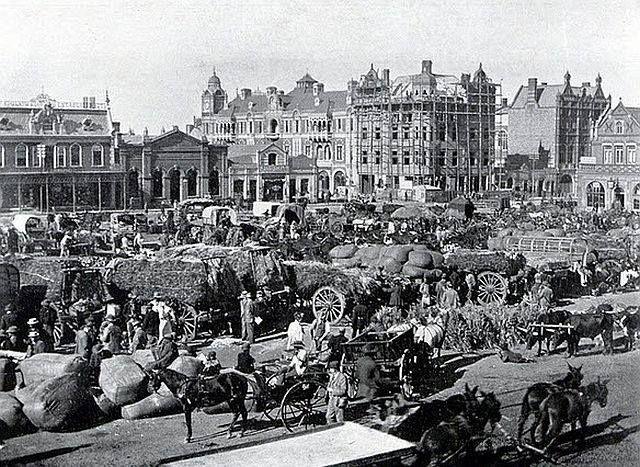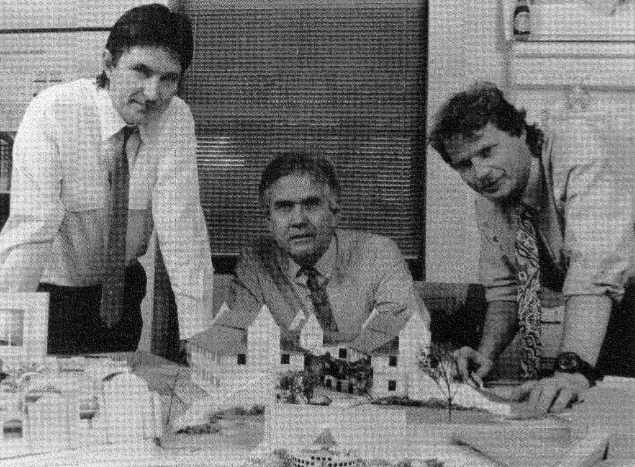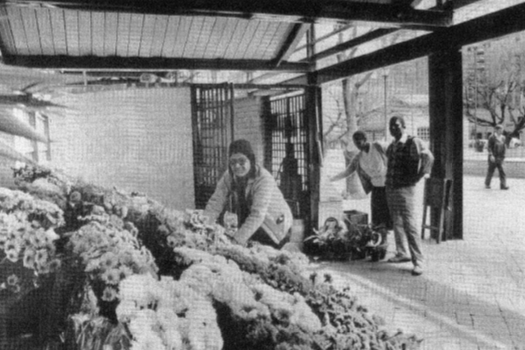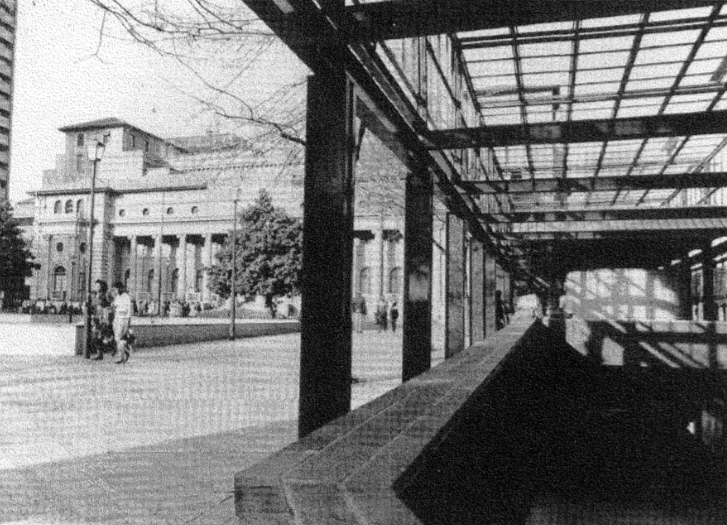
Disclaimer: Any views expressed by individuals and organisations are their own and do not in any way represent the views of The Heritage Portal. If you find any mistakes or historical inaccuracies, please contact the editor.
From 1989-1991 a major project unfolded in the historic centre of Johannesburg. It was known as the Civic Spine Project and aroused considerable debate. Below is an article from the 1991 edition of Restorica which looks at arguments on all sides of the controversy. Thank you to the University of Pretoria and the Heritage Association of South Africa (HASA) for giving us permission to publish.
The water feature between the Rissik Street Post Office and the City Hall still exists in 2016 after being restored in 2011. The controversial structures in Beyers Naude Square were removed at the same time.
Seldom in the history of Johannesburg has a project of a public nature sparked as much controversy as the Civic Spine in the centre of town. Some hate it, others think they may grow to love it.
What it looks like
The Civic Spine project stretches from the Rissik Street Post Office to the City Library. An imposing water feature was erected in the centre of Rissik Street. In the Library Gardens provision has been made for two upmarket restaurants on top of a line of kiosks flanking the gardens along President and Market Streets, where more than 200 trees were planted along the widened and paved sidewalks. The Civic Spine is intended to give the CBD a tree-lined focal point. It runs from the piazza in front of the Library through extensively redesigned gardens and two new fast food outlets above the underground car park access ramps on either side of the Library's fountain court, past the Cenotaph to the public square with its fountain in front of the City Hall - facing a proposed hotel in the existing Rissik Street Post Office.
The water feature symbolizes the Witwatersrand watershed. The two obelisks which rise from the fountain frame the City Hall and Post Office entrances respectively
The fountains were restored in 2011 after 12 years of neglect. With a few interruptions from time to time they continue to flow in 2016. Photo: Brian McKechnie
Why a Civic Spine development?
The sprucing up of the Spine is part of an overall plan to revitalize Johannesburg's CBD, said Alderman Eddie Magid, the City Council's planning and development chairman, when announcing the R10.5 [million] project.
His dream is to see a lively CBD, to turn downtown Johannesburg into an upmarket residential area, a place where people would want to live, to shop and to enjoy themselves.
He envisages young people returning to the area, after an ambitious plan involving pedestrian walkways, sidewalk cafes, live entertainment and a new conference centre is completed.
Justifying the project, councillor Magid said major corporations had decided to invest millions of rands in the CBD as a direct result of the decision taken by the Council to upgrade the city spine - otherwise it would eventually have had a depressed appearance compared to the adjacent developments of the private sector.
"The Civic Spine provides an amenity to many who spend their lunch times and free moments in an area that is crowded with high-rise buildings with nowhere else to go at these times. The people for whom it was built, really enjoy the area," he said recently.
CBD chairman Stan Arenson believes the spine is a positive move to create something worthwhile in the CBD. He says some people will hate it initially, but eventually it will be accepted and people will come 'to want it'.
Various calls have in fact been received from organizations and individuals enquiring about the possibility of utilizing the Library Gardens area of the Civic Spine during lunch hours or weekends. Once regular events are being held, it is anticipated that activity in the area will be stimulated and that the Spine will become a true 'people's place', Magid said.
Already Wednesday is the weekly highlight for many an office worker who enjoys music. Various bands, mostly playing African jazz, provide free entertainment from 12h00 till 14h00.
Controversy and criticism
The execution of the project did not always progress smoothly. Shopkeepers, motorists and pedestrians complained bitterly about the disruption while the construction was in process. Shopkeepers and other tenants threatened legal action because of prolonged disruption.
Traditionalists complain that the square had always served as a public square. Old pictures show it littered with wagons and stalls, but always with open ground. Now shops and buildings on Market and President Streets which once looked on to the Library Gardens face blank walls. The buildings will house restaurants and shops, but one questions recurs: Does the city need them, and does it need them there?
Old photo of Market Square Johannesburg
The big yellow walls which bracket a section of the square are sharply criticized by people who want the square scraped bare again. Councillor Rae Graham is one of them, and also dislikes the twin 'spikes' in Rissik Street between the City Hall and the Post Office.
Architect Willie Meyer, of Meyer Pienaar Smith Architects and Urban Designers who also designed the Rand Afrikaans University, is known for his sense of architectural drama. He defends the high yellow walls saying that they will in time be covered by creepers, so that its texture is immaterial.
Angry motorists complained that they had their cars 'washed' every time they drove past the 'monstrous' fountain, which sprays cars as they drive down Rissik Street. The jets have had to be turned down drastically because of this. Critics maintain this now makes the obelisks appear totally out of scale.
Veterans and ex-servicemen claim that Johannesburg's proud memorial in honour of its its war heroes, the Cenotaph, has been desecrated. Servicemen have accused the Council of destroying the area surrounding the memorial and called for the pulling down of the two-storey-high walls and restoration of the gardens.
A more recent photo of veterans at the Cenotaph (The Heritage Portal)
Conrad Berge, secretary of the Johannesburg Metropolitan Action Group, called the Civic Spine an appalling piece of architectural terrorism and illegitimate planning.
Some people call it an unmitigated disaster. "The Council has wasted resources in mistaken priorities, it is an aesthetic failure and a slap in the face of the black community," writes architect Anthony Lange in the Financial Mail, May 1991. All the symbolism is borrowed from abroad and is inappropriate for South Africa, he alleges. He also comments that the scale of the main square has been destroyed, as well as the setting of all the surrounding buildings.
Reacting to the controversy, architects and urban designers Meyer Pienaar Smith say that no journalist has up to now bothered to ask them for their point of view. "We expected that the spine would raise some controversy. We believe that the extent to which people have become involved is healthy and reflects a successful attempt to identify the Civic Spine as a particular urban precinct. They put their case eloquently:
People identify with places on a variety of levels, from the profound experience of those who feel at home in the place, to those who have no sense of belonging and feel 'outsiders'.
Criticism has mainly come from those who visit the city irregularly and relate to the Civic Spine mainly from the outside, for example, not as users but as passers-through. Of course they are immediately faced with the walls. The Civic Spine is very young - the vegetation and landscaping, vital to the success of the project, has not yet had one growing season. Once the structures are covered with their intended clothing, they will take on their full glory.
As outsiders, these people are seldom aware of deeper layers of meaning and opportunity associated with the scheme. Several surveys conducted by both the City Council and the press have discovered that the vast majority of the users of the Civic Spine precinct have responded positively to the scheme. It is also interesting to note that the scheme has had the support of groups such as the Central Business District Association while others such as the Parktown Residents Association are objectors.
Johannesburg is characterized more by a sense of change than of permanence, but here in the heart of the city is one of the more permanent districts, with specific and general memories. The Civic Spine has reinforced the sense of permanence through the reinforcement of existing patterns and forms. The introduction of new uses and forms grow from existing patterns and are not a major turn around.
Architects Francois Pienaar Willie Meyer and Floris Smith
The zoning problem
Now there is another setback for the project. It turns out that the tall structures closing off the Library Gardens on either side are higher than those originally approved by the City Council. It also appears that the site was not properly rezoned for the shops and restaurants which were to be an integral part of the new development and there was no environmental impact assessment, raising questions about the procedures applied in granting approval for the project.
The ratepayer watchdog organization, the Northern Areas Group (NAG), was concerned that planning laws were being flouted. They intended legal action unless the Council went through a proper public consultation and planning process before letting the buildings. The planning tribunal has twice deferred a decision.
The Parktown Association also picked up the cudgels. In a sharply worded letter to the acting town clerk, the association stressed the significance of the restrictions in the title deeds. These clearly protected the Library Gardens as open space for Johannesburg's citizens: No portion thereof shall be used as shops, offices, rooms or flats for any business or residential purpose whatsoever.
The Council's attitude to these restrictions, says the association, shows contempt for the rights of the ratepayers. It points out that the Council's approval for the "environmental upgrading of the Civic Spine" was radically changed to a commercial project without ever being officially concerned. Nearly R1 million was spent on building shopping space on the square. Four months after the completion of the buildings, no occupation has yet been taken. And it seems the buck is being passed about whose responsibility the rezoning debacle should be. Ratepayers' groups called the R788 000 two storey-high walls illegal and demanded that they be torn down.
"We believe that bulldozing R788 000 worth of Berlin Wall is a small price to pay for getting back Market Square, the city's oldest and most historic place", said Parktown Association representative Flo Bird.
These "industrial sheds" have been fiercely criticized because they allegedly "truncate the west facade of the historic City Hall".
If more space has been developed than originally approved, the whole matter will have to be resubmitted to the full Council for reevaluation before rezoning can proceed. If the city rejects the amendments, it is conceivable that the spine buildings will have to be demolished or modified at the ratepayers expense.
He doesn't think it will come to that, says Stan Arenson, chairman of the CBD. "We will cross that bridge when we get to it, but I don't think it will be torn down," he chuckles. But the legal quagmire may, according to Arenson, last another six to nine months.
Commenting on this hitch, the architects say that the rezoning procedures have been and are the responsibility of the Council. "In our understanding, the issues are really technical. The ground is zoned as public open space, but with the provision that the Council may erect certain structures on the ground. Already the public library books hall, flower sellers and the parking garage had been constructed and the approximately 850 square metres of retail space envisaged will definitely enhance the activity. In order to regularize this situation the Council applied for rezoning. Discrepancies of some 50 square metres appear to have arisen from the use of rough figures. The town planning department of the Johannesburg City Council would be able to provide more detailed information."
What now? Will the Spine eventually be accepted and even loved?
What about the people who actually use the Civic Spine area? Does the public find the Spine user-friendly? After the first highly successful open bookfair at the precinct on the first Sunday in August, Eddie Magid called the project a triumph. Thousands of people flocked to town on that Sunday, some for the first time in years, to attend the fair, and it is said that not since the area used to be Market Square before World War I, had so many people spent the whole day there. Public reaction was very favourable after the fair, clamouring for more events in similar vein.
In July this year, the planning director of the City Council, Mr Ian Symon, said that people making use of the Civic Spine were generally pleased with the area and regarded it as a much better facility than before. A three-day survey carried out by the Council showed that many people used the area regularly and others who had visited it for the first time, said it was pleasant and they would come again.
People did, however, suggest that more seating should be provided and empty stalls in the area have confused many visitors. They also mentioned the cleanliness of the area, especially as many have their lunch there, though there was a need for more refuse bins. The lunchtime music on Wednesdays was popular, but should be better advertised.
One of the market stalls facing the square
"Many people pointed out that this area was more popular in summer. It was felt that the improvement of the facility would lead to crowds frequenting the area as soon as spring started and the days became warmer," he said.
Though shoppers will not be able to make good use of the shops in the development until the rezoning matter is sorted out, Mr Stan Arenson, chairman of the CBD, is happy with the project. "It works, people are going there. To me it signifies the City Council's commitment to the development of the CBD. In time it will have a positive effect on inner city living. Those who dislike it at the moment will become used to the Spine and even grow to love it."
The architects who designed the Spine have the last word: "The improvement has been nothing short of miraculous given the budget. It will provide the robust framework within which a large number of present and future activities can take place, gradually imbuing the Civic Spine with the sense of place which will enable future generations to consider it one of the most memorable places in the city."
Comments will load below. If for any reason none appear click here for some troubleshooting tips. If you would like to post a comment and need instructions click here.

